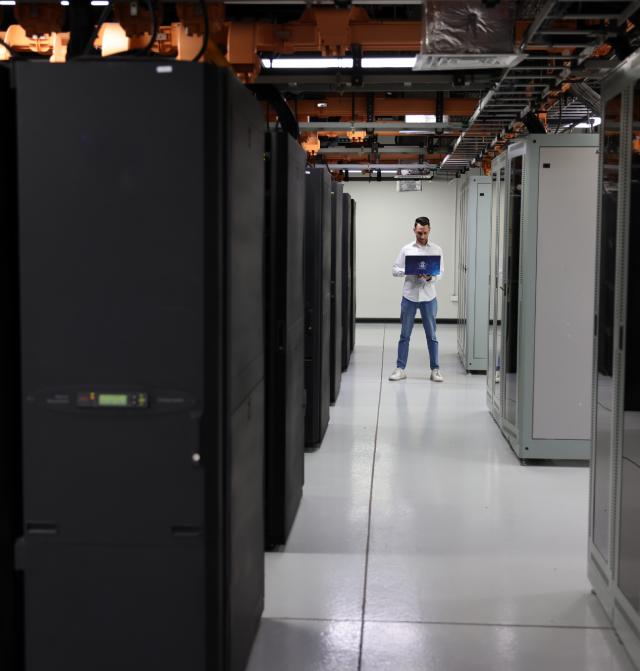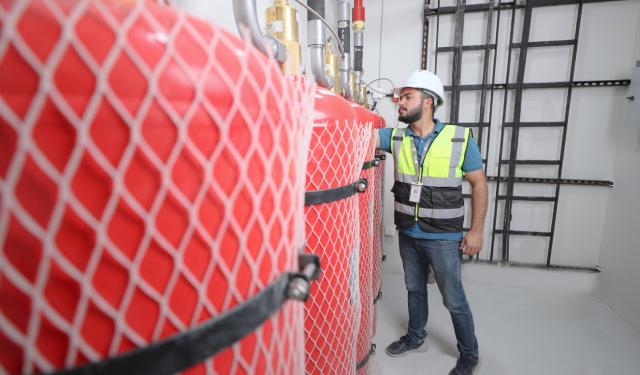
University Data Center Implementation



Client
American University of Iraq-Baghdad
Duration
1 year
Category
Infrastructure Development
Date
2018
Project Summary :
Implementing university Data center (Largest in Iraq) involves setting up a centralized facility to store, manage, and process digital data and applications critical for academic, administrative, and research activities.
Project Scope :
1) Location and Facility Design
1.1 Site Selection :
Choose a suitable location for the data center considering factors like accessibility, security, power availability, and environmental considerations.
1.2 Physical Infrastructure :
Design the data center facility with appropriate space, power, cooling, and physical security measures (e.g., access control, surveillance) to ensure uninterrupted operation and protect sensitive equipment.
2) Data Storage and Servers
2.1 Server Racks and Cabinets :
Install racks and cabinets to house servers, storage arrays, networking equipment, and other hardware components in a structured and organized manner.
2.2 Storage Systems :
Deploy storage systems (e.g., SAN, NAS) to store and manage large volumes of data securely, with features like redundancy, data replication, and backup capabilities.
3) Networking Infrastructure
3.1 Network Connectivity :
Establish high-speed network connectivity within the data center and to external networks (e.g., campus network, internet) to facilitate data transfer and communication.
3.2 Switches and Routers :
Deploy network switches, routers, and other networking devices to interconnect servers, storage systems, and other IT equipment within the data center.
4) Power and Cooling Systems
4.1 Power Distribution :
Design power distribution systems with redundant power sources, backup generators, and uninterruptible power supply (UPS) units to ensure continuous power availability and minimize downtime.
4.2 Cooling Infrastructure :
Install cooling systems (e.g., air conditioning, precision cooling) to maintain optimal temperature and humidity levels within the data center and prevent equipment overheating.
5) Security Measures
5.1 Access Control :
Implement access control mechanisms (e.g., biometric authentication, RFID card readers) to restrict physical access to the data center and prevent unauthorized entry.
5.2 Surveillance Systems :
Deploy surveillance cameras and monitoring systems to monitor the data center premises and detect security breaches or suspicious activities.
5.3 Fire Detection and Suppression :
Install fire detection systems, smoke detectors, and fire suppression systems (e.g., sprinklers, gas suppression) to mitigate the risk of fire-related incidents.
6) Virtualization and Cloud Integration
6.1 Virtualization :
Implement virtualization technologies (e.g., VMware, Hyper-V) to optimize server resource utilization, consolidate workloads, and create virtualized environments for running applications and services.
6.2 Cloud Integration :
Integrate with cloud services and platforms (e.g., AWS, Azure) for backup, disaster recovery, and scalability, leveraging hybrid or multi-cloud architectures as needed.
7) Backup and Disaster Recovery
7.1 Backup Solutions :
Deploy backup solutions (e.g., tape backup, disk-based backup) to regularly back up critical data and ensure data protection and integrity.
7.2 Disaster Recovery Planning :
Develop and implement disaster recovery plans and procedures to minimize data loss and downtime in the event of natural disasters, cyberattacks, or other disruptive events.
8) Monitoring and Management Tools
8.1 Network Monitoring :
Implement network monitoring tools and management software to monitor the performance, availability, and security of the data center infrastructure in real-time.
8.2 Resource Management :
Use resource management tools to optimize resource allocation, track utilization trends, and identify potential bottlenecks or performance issues.

